Nomura Research Institute Bundle
Who Really Controls Nomura Research Institute?
Understanding the intricacies of Nomura Research Institute SWOT Analysis is vital for anyone seeking to navigate the complex world of finance and consulting. Unraveling the NRI ownership structure offers critical insights into its strategic direction and influence within the Japanese financial landscape. A deep dive into Who owns NRI reveals the key players shaping its future and its relationship with its parent company.
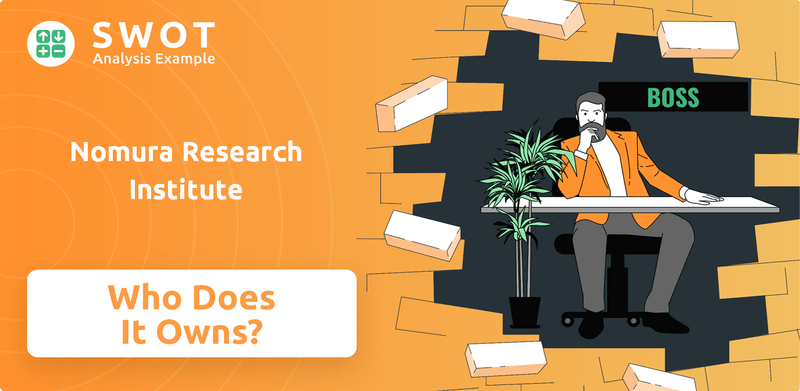
This article will explore the evolution of Nomura Research Institute's ownership, tracing its origins and examining the impact of its listing on the Tokyo Stock Exchange. We'll analyze the roles of major stakeholders and the ongoing relationship with Nomura Holdings, providing a comprehensive view of the company's structure and governance. Understanding the NRI parent company and its influence is key to grasping NRI's operations and strategic direction within the Japanese financial institution sector.
Who Founded Nomura Research Institute?
The genesis of Nomura Research Institute, Ltd. (NRI) traces back to April 1, 1965. It was established from the research division of Nomura Securities Co. This initial structure indicates a close relationship with the Nomura Group from the outset, influencing its early ownership.
Simultaneously, Nomura Computing Center Co., Ltd. (NCC) was founded in January 1966. NCC originated from the Electronic Data Processing Division of Nomura Securities. The formation of both NRI and NCC reflects the Nomura Group's strategic expansion into research and IT solutions.
While specific founder names and initial equity details are not publicly available, the spin-off from Nomura Securities Co. strongly suggests that the Nomura Group held significant early ownership. This structure laid the foundation for NRI's future development and its integration within the broader Nomura ecosystem.
NRI emerged from Nomura Securities' research section.
NCC, the IT arm, was spun off from Nomura Securities' EDP division.
Early ownership was likely dominated by the Nomura Group.
The spin-offs aligned with Nomura's broader objectives.
In January 1988, the merger of Nomura Research Institute, Ltd. and Nomura Computer Systems Co., Ltd. (formerly NCC) created the current Nomura Research Institute, Ltd. This consolidation strengthened NRI's position as a comprehensive provider of research, consulting, IT solutions, and system operations. This merger further streamlined the relationship between the parent company and its subsidiaries. For more detailed information, you can refer to the article about Nomura Research Institute.
Understanding the early ownership structure of Nomura Research Institute is crucial for grasping its evolution and its ties to Nomura Holdings. The company's formation from Nomura Securities and the subsequent merger highlight the strategic integration within the Nomura Group.
- NRI originated from Nomura Securities' research division.
- NCC, the IT arm, was spun off from Nomura Securities' Electronic Data Processing Division.
- The Nomura Group likely held significant early ownership.
- The 1988 merger consolidated IT and research functions.
Nomura Research Institute SWOT Analysis
- Complete SWOT Breakdown
- Fully Customizable
- Editable in Excel & Word
- Professional Formatting
- Investor-Ready Format
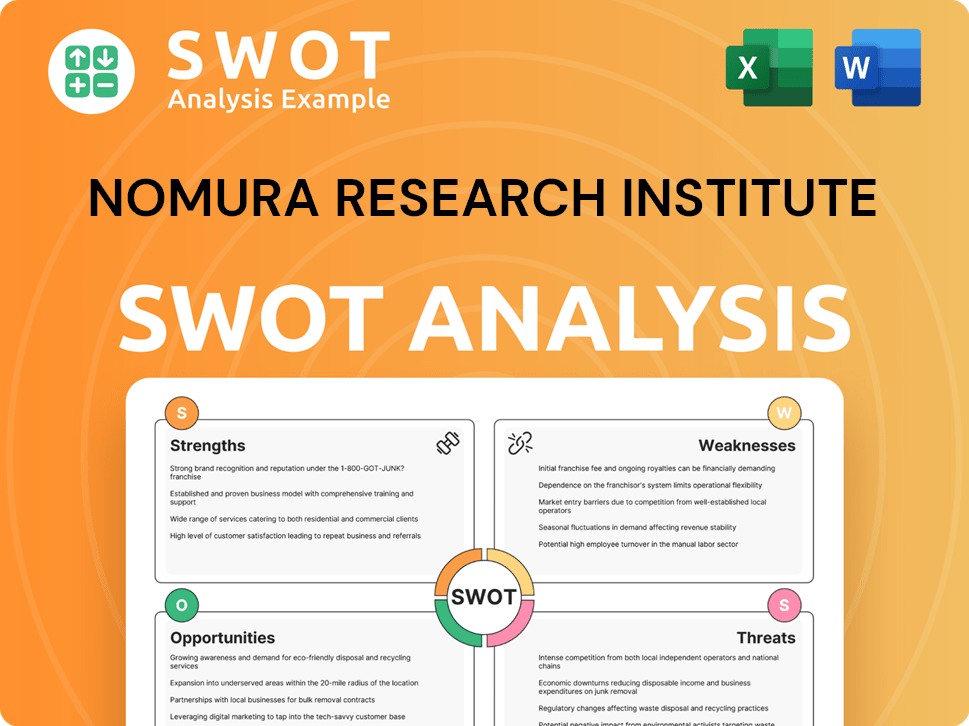
How Has Nomura Research Institute’s Ownership Changed Over Time?
The ownership structure of Nomura Research Institute (NRI), a publicly traded entity on the Tokyo Stock Exchange (TYO: 4307), has evolved over time. While a brief history of Nomura Research Institute reveals its origins, the company's relationship with Nomura Holdings, Inc. is key to understanding its ownership dynamics. Although Nomura Holdings maintains a significant stake, NRI operates independently.
A notable shift occurred when Nomura Holdings tendered shares in a self-tender offer by NRI. This action changed Nomura Holdings' percentage of shares to total outstanding shares in NRI, including shares held by Nomura Facilities, Inc., a wholly-owned subsidiary of Nomura Holdings. As of March 31, 2019, Nomura Holdings held 36.59% of the shares. However, by March 31, 2025, this had decreased to 23.07%. Despite this change, NRI is expected to remain an equity method affiliate of Nomura Holdings on a consolidated basis.
| Shareholder | Percentage of Shares (as of March 31, 2025) | Notes |
|---|---|---|
| Nomura Holdings, Inc. | 23.07% | Includes shares held by Nomura Facilities, Inc. |
| The Master Trust Bank of Japan, Ltd. (Trust Account) | 16.31% | Major Institutional Shareholder |
| Custody Bank of Japan (Trust Account) | 5.15% | Significant Institutional Investor |
As of March 31, 2025, major institutional shareholders of NRI include The Master Trust Bank of Japan, Ltd. (Trust Account) with 16.31% of issued shares, and Custody Bank of Japan (Trust Account) with 5.15%. Other significant investors include State Street Bank and Trust Company, The Bank of New York Mellon as Depositary Bank for DR Holders, JPMorgan Securities Japan Co., Ltd., SMBC Nikko Securities Inc., and JP Morgan Chase Bank across various accounts. The company's equity for the fiscal year ending March 2025 is 434.04 billion JPY. This demonstrates a broad investor base beyond the direct affiliation with Nomura Holdings, underscoring NRI's status as an independent entity with diverse ownership.
NRI is a publicly traded company, not a subsidiary of Nomura Holdings, despite the capital ties.
- Nomura Holdings remains a significant shareholder, although its stake has decreased.
- Major institutional investors hold substantial portions of NRI's shares.
- The company's equity for the fiscal year ending March 2025 is 434.04 billion JPY.
- The ownership structure reflects a broad investor base.
Nomura Research Institute PESTLE Analysis
- Covers All 6 PESTLE Categories
- No Research Needed – Save Hours of Work
- Built by Experts, Trusted by Consultants
- Instant Download, Ready to Use
- 100% Editable, Fully Customizable
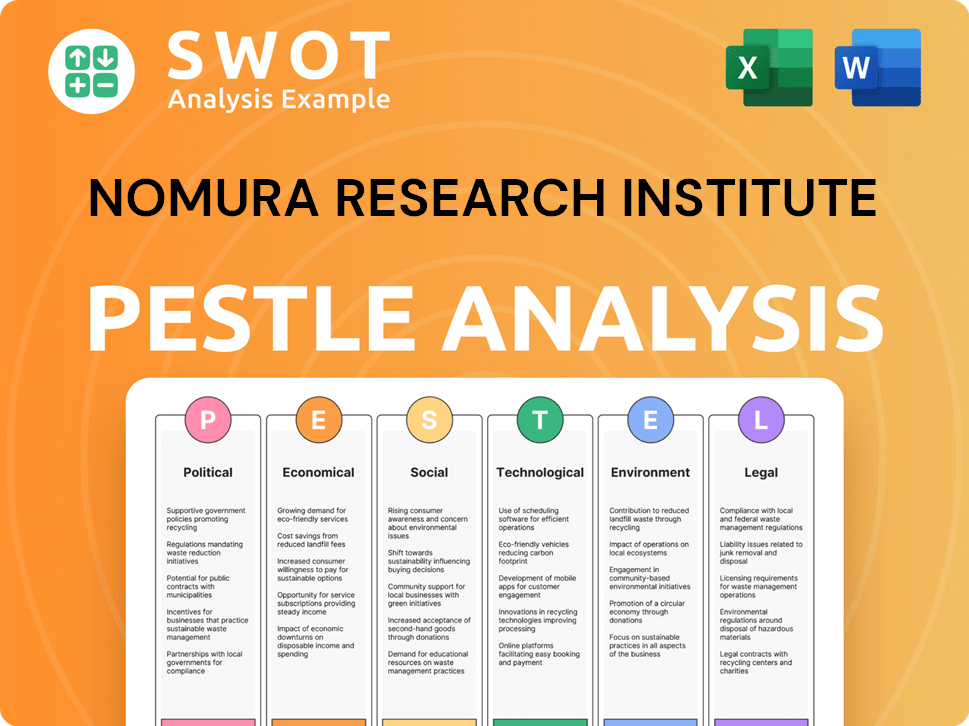
Who Sits on Nomura Research Institute’s Board?
The Board of Directors of Nomura Research Institute (NRI) is pivotal in steering the company's strategic direction. As of April 1, 2024, Kaga Yanagisawa assumed the roles of President and CEO, succeeding Shingo Konomoto, who became Chairman, Member of the Board, and Representative Director. The leadership team also includes key figures such as Yo Akatsuka as Vice Chairman, Fumihiko Sagano as Senior Executive Managing Director and Director, and Hidenori Anzai, also a Senior Executive Managing Director and Director. Hidenori Anzai is slated to retire from the board following the 60th Ordinary General Meeting of Shareholders in June 2025.
The board's composition reflects a mix of executive and, implicitly, independent directors, ensuring a balance of perspectives in decision-making. The average tenure of the board members is approximately 3.4 years, indicating a blend of experience and fresh insights within the leadership structure. Understanding the Marketing Strategy of Nomura Research Institute provides additional context on how the company operates.
| Board Member | Title | As of |
|---|---|---|
| Kaga Yanagisawa | President and CEO | April 1, 2024 |
| Shingo Konomoto | Chairman, Member of the Board, Representative Director | April 1, 2024 |
| Yo Akatsuka | Vice Chairman | April 2025 |
| Fumihiko Sagano | Senior Executive Managing Director and Director | April 2025 |
| Hidenori Anzai | Senior Executive Managing Director and Director | April 2025 (Retiring June 2025) |
NRI's voting structure is based on a public K.K. (Kabushiki Kaisha) model, adhering to a one-share-one-vote system for common shares. There is no publicly available information suggesting the presence of dual-class shares, special voting rights, or founder shares. This structure ensures that voting power is directly proportional to share ownership, providing a clear and equitable governance framework for shareholders. The company's structure is designed to maintain transparency and fairness in its operations, reflecting its status as a Japanese financial institution.
The ownership of Nomura Research Institute is primarily determined by its shareholder structure, operating under a one-share-one-vote system. This structure indicates that voting rights are allocated based on the number of shares held, ensuring a fair and transparent governance process. Understanding the shareholders of NRI is key to understanding its operations.
- Public K.K. (Kabushiki Kaisha) structure.
- One-share-one-vote system.
- No dual-class shares or special voting rights.
- Transparent governance framework.
Nomura Research Institute Business Model Canvas
- Complete 9-Block Business Model Canvas
- Effortlessly Communicate Your Business Strategy
- Investor-Ready BMC Format
- 100% Editable and Customizable
- Clear and Structured Layout
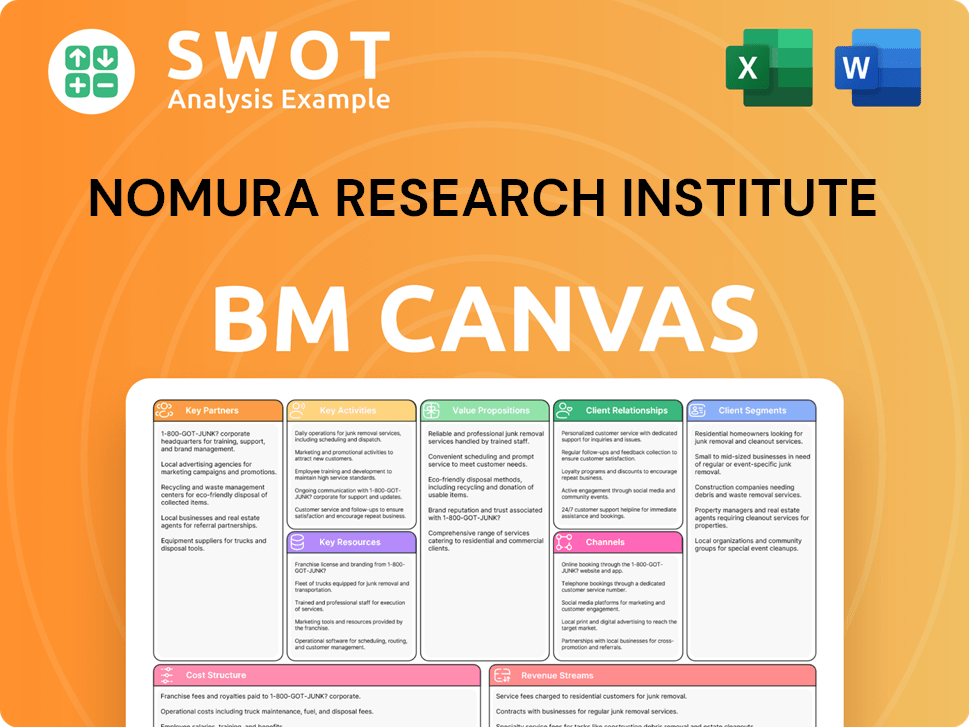
What Recent Changes Have Shaped Nomura Research Institute’s Ownership Landscape?
Over the past few years, Nomura Research Institute's (NRI) ownership structure has seen some key developments. As of March 31, 2025, NRI held 206,974 thousand shares of treasury stock. This indicates ongoing management of the company's capital structure.
In the fiscal year ending March 31, 2025, NRI declared a dividend of ¥34.00 per share, resulting in a total payment of ¥19,515 million. Additionally, a share buyback program was announced on April 25, 2024, for 10,000,000 shares, representing 1.72% for ¥30,000 million. This buyback was completed by October 25, 2024, with 6,498,500 shares repurchased for ¥29,999.63 million. These actions reflect the company's approach to capital allocation and shareholder value.
| Key Ownership Events | Details | Date |
|---|---|---|
| Treasury Stock | 206,974 thousand shares | March 31, 2025 |
| Dividend Per Share | ¥34.00 | Fiscal Year Ending March 31, 2025 |
| Share Buyback Announcement | 10,000,000 shares, 1.72% for ¥30,000 million | April 25, 2024 |
| Share Buyback Completion | 6,498,500 shares repurchased for ¥29,999.63 million | October 25, 2024 |
Nomura Holdings, a major shareholder, approved a share buyback program from May 15, 2025, to December 30, 2025, with an upper limit of 100 million shares, or 3.2 percent of outstanding shares, and an aggregate repurchase price of 60 billion yen. This program aims to increase capital efficiency. While Nomura Holdings is a significant stakeholder, it has stated it is not currently considering a change in its stake in NRI. The evolving landscape of cross-shareholdings in the Japanese equity market and the increasing influence of institutional investors also play a role in shaping NRI's shareholder base.
NRI's ownership is influenced by factors such as share buybacks and dividends. Nomura Holdings, as a major shareholder, has a stated commitment to its current stake. Industry trends, like the decline in cross-shareholdings, impact the shareholder landscape.
Identifying the major stakeholders is crucial for understanding the company's direction. Nomura Holdings is a primary shareholder, with other institutional investors also playing a role. The company's commitment to sustainable management may attract specific investor profiles.
Share buybacks and dividend payments are important indicators of financial health and shareholder value. The company's financial performance directly influences its ownership structure. These financial actions reflect strategic capital allocation decisions.
Broader industry trends, such as decreased cross-shareholdings, impact the shareholder base. The increasing focus on ESG information may also attract specific investor profiles. Active engagement from institutional investors is becoming more prominent.
Nomura Research Institute Porter's Five Forces Analysis
- Covers All 5 Competitive Forces in Detail
- Structured for Consultants, Students, and Founders
- 100% Editable in Microsoft Word & Excel
- Instant Digital Download – Use Immediately
- Compatible with Mac & PC – Fully Unlocked
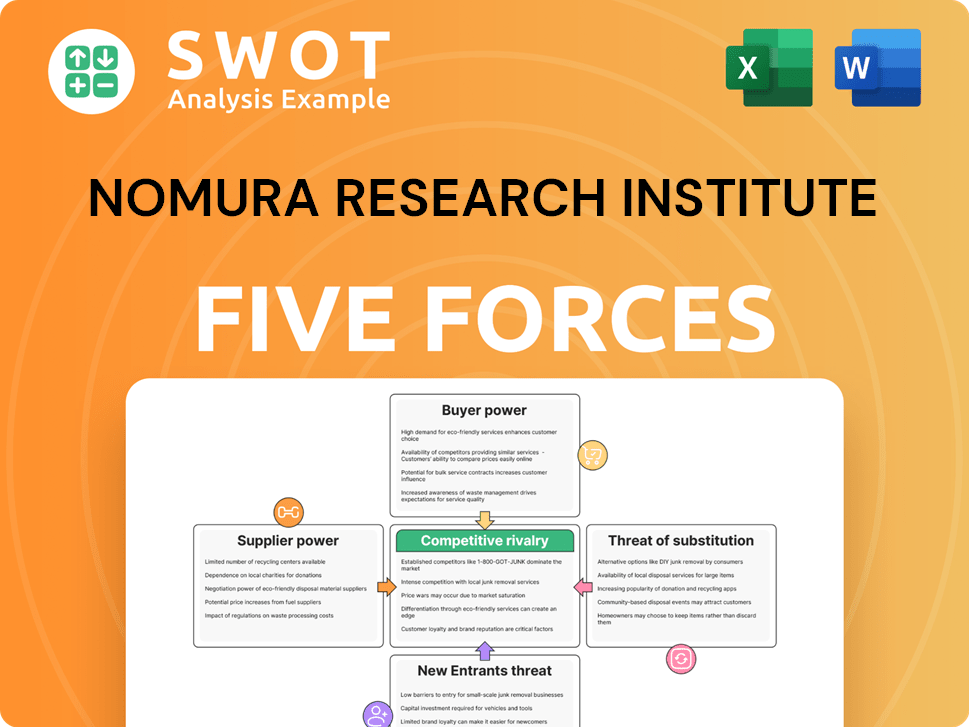
Related Blogs
- What are Mission Vision & Core Values of Nomura Research Institute Company?
- What is Competitive Landscape of Nomura Research Institute Company?
- What is Growth Strategy and Future Prospects of Nomura Research Institute Company?
- How Does Nomura Research Institute Company Work?
- What is Sales and Marketing Strategy of Nomura Research Institute Company?
- What is Brief History of Nomura Research Institute Company?
- What is Customer Demographics and Target Market of Nomura Research Institute Company?
Disclaimer
All information, articles, and product details provided on this website are for general informational and educational purposes only. We do not claim any ownership over, nor do we intend to infringe upon, any trademarks, copyrights, logos, brand names, or other intellectual property mentioned or depicted on this site. Such intellectual property remains the property of its respective owners, and any references here are made solely for identification or informational purposes, without implying any affiliation, endorsement, or partnership.
We make no representations or warranties, express or implied, regarding the accuracy, completeness, or suitability of any content or products presented. Nothing on this website should be construed as legal, tax, investment, financial, medical, or other professional advice. In addition, no part of this site—including articles or product references—constitutes a solicitation, recommendation, endorsement, advertisement, or offer to buy or sell any securities, franchises, or other financial instruments, particularly in jurisdictions where such activity would be unlawful.
All content is of a general nature and may not address the specific circumstances of any individual or entity. It is not a substitute for professional advice or services. Any actions you take based on the information provided here are strictly at your own risk. You accept full responsibility for any decisions or outcomes arising from your use of this website and agree to release us from any liability in connection with your use of, or reliance upon, the content or products found herein.